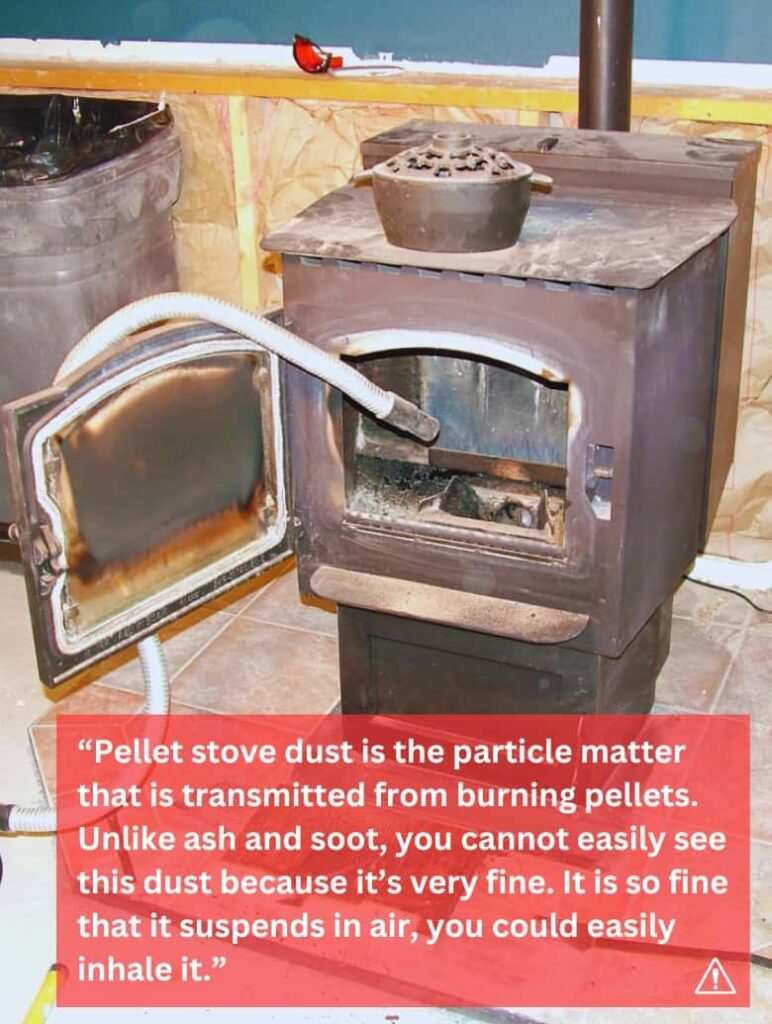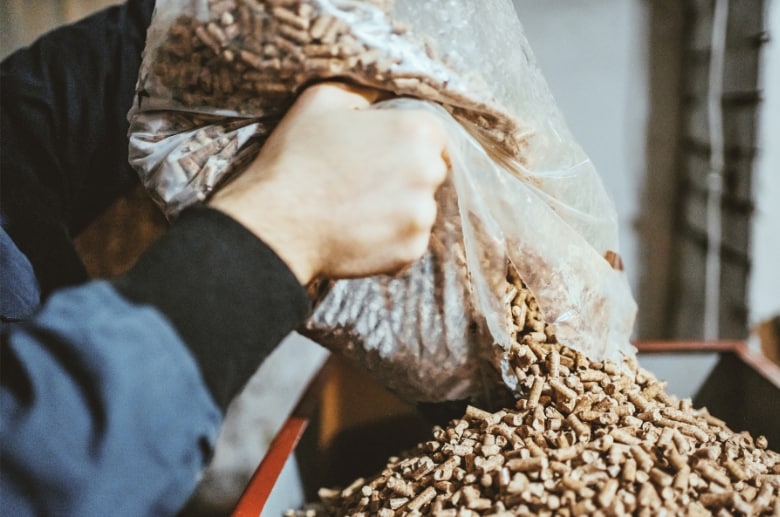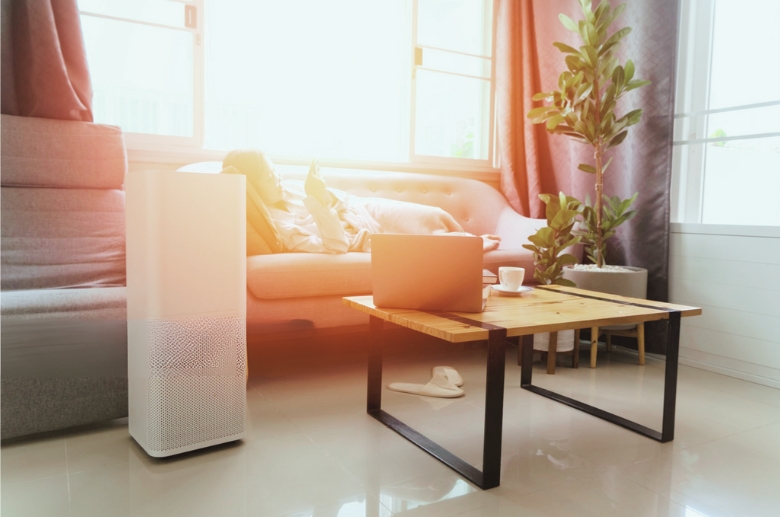Pellet stoves are a widely adopted approach for warming homes because they are clean and energy efficient. Despite being around for many decades, there’s one problem with these stoves that has no solution yet: pellet stove dust.
This refers to the dust emitted by pellet stoves which are ultra-fine and can be a health risk to anyone who inhales it. If you use your stove frequently as a source of heat, you cannot avoid the dust particles produced by the burning of wood pellets.
What is Pellet Stove Dust?

Pellet stove dust is the particle matter that is transmitted from burning pellets. Unlike ash and soot, you cannot easily see this dust because it’s very fine. It is so fine that it suspends in air, you could easily inhale it. Despite being more environmentally friendly, pellets can transmit more particulate matter than oil and gas heat options.
Unlike wood-burning stoves which require the use of seasoned firewood, pellet stoves only need wood pellets. These pellets are made of compressed scrap wood material like sawdust and unused wood, and they’re often sold in bulk via large plastic bags.
To use, pour the pellets into the stove’s storage compartment, and the sensor will then trigger the stove to deliver the pellets from the storage area to the burn chamber. It then prompts you if you need more fuel to start a fire. The stove will burn enough pellets to maintain a small fire.
——
Do You Need to Hire Chimney & Fireplace Expert?
Get free quotes from qualified experts near you. No commitment required!
——
Causes Of Excessive Dust From Pellet Stove
There are several reasons why your pellet stove could be producing excessive dust. Here are some of them:

- Poor installation: If the vent system for your pellet stove dust is not installed properly, large quantities of dust particles could be getting into your home each time you use your stove.
- Pellet combustion Issues: When these wood pellets are shipped via cargo, they can potentially break apart, so it’s not surprising to find some bags containing dust and small pellet chips. Once broken, these pellets don’t work as efficiently in the stove and can release more dust than normal during combustion.
- Handling and Storage of Pellets: Improper handling and storage can also cause pellets to produce excessive dust. Avoid frequently jostling the bags to prevent the pellets from breaking apart. You also want to make sure your pellets are stored in a dry place where they are not exposed to moisture. Leaving pellets exposed to the weather can weaken them.
- Residue Accumulation: If you use the pellet stove regularly, it’s unavoidable that there will be a buildup of particles. The residue that accumulates in the stove can impact its performance, causing it to produce excessive dust.
- Neglected Maintenance: A poorly maintained pellet stove can greatly cause excess dust. Regular checks and cleaning of various stove components are essential for minimizing dust emissions.
Health Hazards of Dust From Pellet Stove

Pellet stoves emit more ultra-fine dust than gas or electric heating stoves. In one study observing wood pellet workers, they found that the workers had a higher frequency of nasal symptoms, dry cough, and asthma compared to the general population.
Despite the pellet stove being more energy efficient than the wood stove, it still emits more ultrafine dust. The wood stove produces about 3.5 kg of fine dust per 1000 hours, while pellet stoves produce 0.68kg. It may seem less, but the pellet stove produces more fine dust compared to gas or electric heaters.
These ultrafine particles are so small that they become suspended in the air, making them easy to inhale. They can penetrate the deepest part of the lungs and can enter the bloodstream, causing health problems, especially for those with existing respiratory issues like asthma, bronchitis, and COPD.
It’s important to be aware of this so you’re able to install and operate your pellet stove properly as well as maintain it regularly.
In addition, you cannot just use any wood pellet product in the market. You have to be selective when buying because some wood pellets can contain heavy metals like arsenic, copper, chromium, and cadmium.
Pellet stoves also produce carbon monoxide when burning wood pellets. Even with a chimney flue that takes all that waste air to the outside, carbon monoxide levels can still increase in your home. If undetected, it can lead to serious health problems and even death. To avoid this, install carbon monoxide (CO) detectors in your house, which can help warn you if it has reached dangerous levels.
Solutions for Reducing Pellet Stove Dust
Pellet stoves may pose all these risks mentioned above, but it doesn’t mean you have to completely remove them from your home. There are certain measures you can take to reduce dust so it’s not as toxic.
1. Choosing the Right Pellets
Choosing the right pellet products can make a big difference in minimizing the amount of dust produced by your stove. Customers often get confused about what pellets to buy since they come in different types.
Wood pellets are usually distinguished into two grades: standard and premium. They are also made up of two types of wood. Softwood and hardwood. Let’s first discuss choosing wood pellets based on grade.
For the least dust, go for premium-grade wood pellets as these have less than 1% ash content compared to standard ones, which have 1% to 3%. They also have less moisture content, which means they burn more efficiently and produce less waste. This efficiency is crucial when addressing issues like pellet stove high pellet consumption, where choosing the right grade of pellets can significantly impact fuel usage and overall stove performance.
You may also come across softwood and hardwood options. Softwood was found to have significantly higher dust emission than hardwood pellets. So, if you have to pick between the two in terms of reducing dust, opt for hardwood.
The best wood pellets are dry ones with the least moisture content. These types produce more heat and will also have low ash content. Also, check for multiple synthetic fillers like bark, cardboard, glue, and other recycled materials. Wood pellets that have these tend to produce excess smoke and ash and should, therefore, be avoided.
2. Maintaining Adequate Ventilation

Proper ventilation is essential to reducing pellet stove dust from your home. A simple way to keep the air flowing in your home is by opening curtain windows and doors to let outside air in. This is only applicable if you live in an area where outdoor air is clean and has minimal pollution.
Understanding the pellet stove chimney requirements is crucial for ensuring efficient operation and reducing indoor pollution. While exploring ventilation options, it’s important to consider whether your pellet stove setup meets these requirements for safe and effective use. Proper chimney or venting system installation can significantly impact the stove’s performance and the air quality in your home.
If you use the furnace fan to circulate air in your home, check the filter to see if it’s trapping dust. If you notice that it’s already full, replace it with a new filter so it’s constantly collecting more dust.
It would also help if you also got your home’s vent and ductwork cleaned. If these are working efficiently, you can greatly reduce the amount of dust circulating indoors.
3. Utilizing Air Purifiers
Air purifiers are very effective at getting rid of fine dust. Aside from dust, it also removes other types of pollutants and allergens like pollen, bacteria, and viruses. When you have an air purifier in your home, you ensure that you’re getting the most optimal indoor air.
Get an air purifier with a true HEPA filter since they are proven to improve indoor air quality in wood-burning communities.
4. DIY Air Filtration System
You can also create an air filtration system called the Corsi-Rosenthal Box, which is specially designed to reduce dust near the pellet stove. It works the same way as an air purifier but this solution is more cost effective. You can build this in a day and use it immediately to capture that fine dust that is often hard to control.
5. Seeking Professional Assistance for Deep Cleaning
Another great way to reduce pellet stove dust is by getting professionals to do a deep cleaning for you. Professionals have all the tools and materials required for cleaning the pellet stove properly. If you don’t want to have to go through the hassle of dusting your pellet stove, it’s best to leave it to the professionals. They’ll do a better job and give you peace of mind.
——
Do You Need to Hire Chimney & Fireplace Expert?
Get free quotes from qualified experts near you. No commitment required!
——
Pellet Stove Maintenance and Cleaning Tips
Pellet stove maintenance is essential to keep your stove running efficiently and only producing the least amount of dust. Follow these steps for maintenance and cleaning for a pellet stove that you’ll enjoy using for the many years to come.
- Clean it regularly: Your pellet stove will work more efficiently if you take the time to clean all of its parts regularly. Remove any dust inside and outside of your stove. Check around the motor and internal parts to see if it has dust buildup that needs cleaning. When it’s clean, the air inside the stove can circulate better, allowing for appropriate combustion in the firebox.
- Have all cleaning tools ready: You should have all the necessary tools required for regular cleaning. To clean your pellet stove, you will need a few simple tools, including towels, a stiff brush, a duster, a flashlight, a shop vac, and a scraping rod. Also, have dust protection ready, like gloves and a dust mask.
Every time you turn off your pellet stove, use a stiff brush to clean the dust produced by the stove. Its size should be right enough to get into small cracks and spaces where dust falls. After you sweep the dust into a collection pan, vacuum the ash out.
A thorough cleaning of your pellet stove each month will save you plenty of time having to do a deep cleaning every few months. - Check the other areas of your pellet stove: You also need to check your gaskets and motors to see if they are running freely. Pellet stove repair might be a part of your to-do list if some of these parts don’t work well.
For the best results, have it checked by a professional furnace cleaner every year. They will be able to look into difficult-to-reach areas of your fireplace and see if anything needs replacing or fixing. Don’t forget to clean the firepot as well.
Conclusion
A pellet stove is an amazing appliance for home heating, although potential health risks might make you think twice about using it. However, by following the cleaning steps we’ve shared, you can significantly reduce these risks.
To experience fewer dust-related issues, choose high-quality hardwood pellets and equip your home with an air purifier, effectively controlling the dust levels.
If cleaning the stove is too big of a project for you, consider calling a professional today to help guide you in maintaining your pellet wood stove.






